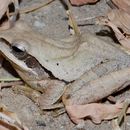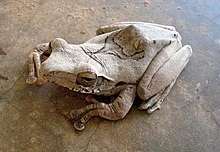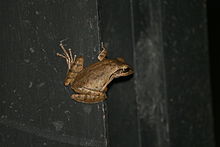pt-BR
nomes no trilho de navegação


Polypedates maculatus és una espècie d'amfibi que viu al sud d'Àsia.
Es troba amenaçada d'extinció per la pèrdua del seu hàbitat natural.
Polypedates maculatus és una espècie d'amfibi que viu al sud d'Àsia.
Es troba amenaçada d'extinció per la pèrdua del seu hàbitat natural.
இந்திய மரத் தவளை[2] (Polypedates maculatus), இமயமலை மரத் தவளை [1] என்பது தெற்கு ஆசியாவில் காணப்படும் ஒரு பொதுவான மரத் தவளை வகை ஆகும். இதை 1830 இல் ஜான் எட்வர்ட் கிரே விவரித்தார்.
இந்த தவளைகளானது சுமார் 7–8 செ.மீ. உடல் நீளம் கொண்டவை. இவை பெரும்பாலும் பழுப்பு, மஞ்சள், சாம்பல் அல்லது மேலே வெண்மையான நிறத்தைக் கொண்டவையாக இருக்கும். உடலில் புள்ளிகள் அல்லது திட்டுகளுடன் இருக்கும். மேலும் அரிதாக தலையின் பின்புறம் மற்றும் பின்புறத்தின் முன்புறத்தில் மணற்கடிகை வடிவ உருவத்துடன் இருக்கும். லோரல் மற்றும் கன்னப் பொட்டு எலும்புப் பகுதிகள் கருத்திருக்கும். மேல் உதட்டில் ஒரு மெல்லிய கோடு இருக்கும். தொடைகளின் பின்புறம் வட்டமான, மஞ்சள் புள்ளிகளைக் கொண்டிருக்கும், இவை பொதுவாக அடர்-பழுப்பு அல்லது ஊதா நிற வலைப்பின்னலால் பிரிக்கப்படுகின்றன. மேலே உள்ள தோல் மென்மையானது. கண்ணிலிருந்து தோள்பட்டை வரை ஒரு மடிப்பு நீண்டுள்ளது. ஆண் தவளைகளுக்கு உள் குரல் பைகள் உள்ளன. [3]
இவை பூட்டான், இந்தியா, நேபாளம் , இலங்கை, மேற்கு மற்றும் தெற்கு வங்காளதேசம் முதல் சிட்டகாங் மாவட்டம் வரை பரவலாக உள்ளன; மேலும் இதன் எல்லைக்கு அருகிலுள்ள சீனா மற்றும் மியான்மரிலும் பரவி இருக்ககூடும். இந்த தவளை பன்னாட்டு இயற்கைப் பாதுகாப்புச் சங்கத்தால் தீவாய்ப்பு கவலை குறைந்த இனமாக பட்டியலிட்டுள்ளது. [1]
|url= (help).|url= (help).|url= (help).இந்திய மரத் தவளை (Polypedates maculatus), இமயமலை மரத் தவளை என்பது தெற்கு ஆசியாவில் காணப்படும் ஒரு பொதுவான மரத் தவளை வகை ஆகும். இதை 1830 இல் ஜான் எட்வர்ட் கிரே விவரித்தார்.

Polypedates maculatus, the Indian tree frog,[1] or Chunam tree frog, is a common species of tree frog found in South Asia. It was described by John Edward Gray in 1830.[2]
Although now considered as a separate species again, for a time, the Himalayan tree frog was considered as a subspecies of the Indian tree frog (as P. m. himalayensis).[1] Polypedates leucomystax, a very similar species, was formerly included in P. maculatus.



These frogs measure about 7–8 cm in body length. They are mostly brownish, yellowish, greyish, or whitish above, with darker spots or markings, rarely with an hourglass-shaped figure on the back of the head and the front of the back. The loreal and temporal regions are dark; there is a light line on the upper lip. The hind side of the thighs has round, yellow spots, which are usually separated by a dark-brown or purplish network. The skin is smooth above, and granulated on the belly and under the thighs; a fold extends from the eye to the shoulder. Males have internal vocal sacs.[3]
The vomerine teeth are arranged in two more or less oblique series between the choanae or commencing close to the inner front edge of the latter. The skin of head is free; a more or less developed bony arch – sometimes slender and partly ligamentous, sometimes very thick and swollen – extends on each side from the posterior border of the frontoparietal bones to the squamosals. The snout is pointed with a rounded tip, about as long as the diameter of the orbit, the canthus rostralis is distinct, and the loral region is concave. The nostril is located much nearer to the end of the snout than to the eye. The interorbital space is broader than the upper eyelid. The eardrum measures about three-fourths the diameter of the eye.[3]
The fingers are barely webbed, and the toes are two-thirds webbed. The disks of fingers and toes are moderately developed; that of the third finger measures two-fifths to one-half the diameter of the eye. The subarticular tubercles are of moderate size. When the hind leg is held alongside the body, the tibiotarsal articulation reaches the eye, or between the eye and the tip of the snout.[3]
It is widespread throughout Bhutan, India, Nepal, and Sri Lanka, as well as western and southern Bangladesh to Chittagong District; its range might also extend into nearby China and Myanmar. This common and adaptable frog is listed as Least Concern by the IUCN.[1]
They may use day roosts regularly. Their call is a sudden short and rapid series of rattling rat-tats.[4]
They wipe themselves with skin secretions consisting of mucus and lipids that help in reducing moisture loss. When temperatures are higher, they secrete from the skin ("sweat"), pant, and adopt lighter skin colours.[5]
In south India they can be a nuisance to households as they enter homes in search of food. They can climb walls with the help of their webbed feet and reach even higher floors, entering through the open windows.
{{cite journal}}: CS1 maint: multiple names: authors list (link) Polypedates maculatus, the Indian tree frog, or Chunam tree frog, is a common species of tree frog found in South Asia. It was described by John Edward Gray in 1830.
Although now considered as a separate species again, for a time, the Himalayan tree frog was considered as a subspecies of the Indian tree frog (as P. m. himalayensis). Polypedates leucomystax, a very similar species, was formerly included in P. maculatus.
Polypedates maculatus es una especie de anfibios anuros de la familia Rhacophoridae.[2]
Habitan en el subcontinente indio.
Esta especie se encuentra en peligro por la pérdida de su hábitat natural.
Polypedates maculatus es una especie de anfibios anuros de la familia Rhacophoridae.
Habitan en el subcontinente indio.
Esta especie se encuentra en peligro por la pérdida de su hábitat natural.
Polypedates maculatus Polypedates generoko animalia da. Anfibioen barruko Rhacophoridae familian sailkatuta dago, Anura ordenan.
Polypedates maculatus Polypedates generoko animalia da. Anfibioen barruko Rhacophoridae familian sailkatuta dago, Anura ordenan.
Polypedates maculatus est une espèce d'amphibiens de la famille des Rhacophoridae[1].
Cette espèce se rencontre, du niveau de la mer jusqu'en dessous de 3 000 m d'altitude au Bangladesh, au Bhoutan, en Inde, au Népal et au Sri Lanka[1].
Polypedates maculatus mesure de 34 à 57 mm pour les mâles et de 44 à 89 mm pour les femelles.
Polypedates maculatus est une espèce d'amphibiens de la famille des Rhacophoridae.